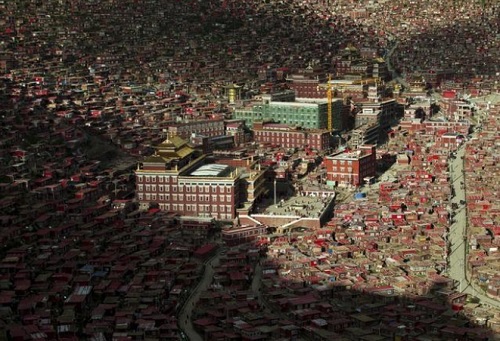BEIJING (Reuters) - Chinese officials are engaging in a “takeover” of one of the world’s largest Tibetan Buddhist monasteries with a plan to put Communist Party officials in charge of its administration, Human Rights Watch (HRW) said on Wednesday.

View shows the settlements of Larung Gar Buddhist Academy in Sertar County of Garze Tibetan Autonomous Prefecture, Sichuan province, China, July 23, 2015. REUTERS/Stringer
Larung Gar, a sprawling Buddhist center of learning and prayer in the mountains of southwestern Sichuan province, has already been reduced in size through an eight-month program of demolition and expulsion that ended in April 2017, HRW said.
The government is now splitting the center into two sections, an academy and a monastery, divided by a wall, according to an English-language translation of a document shared by HRW, which they said was received in August 2017.
The measures include quotas for recruitment, a management system of “real-name registration” and tags for monks and nuns, as well as placing 97 Communist Party cadres, who are required to be atheist, in top finance, security and admission roles.
Monastic sources told HRW that a similar system would be set up in the monastery and that a large building had been constructed to house the cadres.
Reuters could not independently verify the authenticity of the document or the claims from HRW sources.
“The administrative takeover of Larung Gar by party officials shows that the government’s aim was not merely to reduce numbers at the settlement,” said Sophie Richardson, U.S.-based China director for HRW.
“Chinese authorities are also imposing pervasive control and surveillance over every level of activity within religious communities,” she said.
China’s religious affairs bureau did not respond immediately to a request for comment.
China has denied carrying out demolitions at Larung Gar, saying the work is to tackle fire and safety hazards, as well as to “reconstruct” old buildings.
Tibetan-populated areas of western China, including in Sichuan, had been at the epicenter of protests against Chinese rule, which included acts of self-immolation, although reported cases have declined in the past two years.
HRW’s Richardson said the micromanagement of Larung Gar encroaches on religious freedom and is likely to fuel resentment against Beijing.
Chinese law promises freedom of religion but authorities keep a close eye on religious believers and institutions, especially in areas such as Tibet where faith is considered a potential challenge to Communist Party rule.
New regulations due to take effect at the end of this month are set to expand state oversight of religious institutions. In particular, schools will train future generations of China’s religious leaders.
Leave Comments